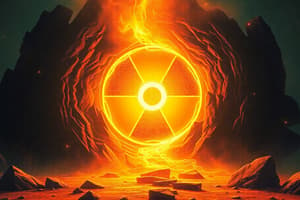Podcast
Questions and Answers
Which type of radioactive decay involves the emission of an alpha particle?
Which type of radioactive decay involves the emission of an alpha particle?
- Gamma decay
- Beta decay
- Delta decay
- Alpha decay (correct)
What is emitted during beta decay?
What is emitted during beta decay?
- Photon
- Electron (correct)
- Proton
- Neutrino
Which type of decay occurs when an excited nucleus emits gamma rays?
Which type of decay occurs when an excited nucleus emits gamma rays?
- Beta decay
- Alpha decay
- Gamma decay (correct)
- Theta decay
Which model of radioactive decay is characterized by a constant decay rate?
Which model of radioactive decay is characterized by a constant decay rate?
What does the half-life of a radioactive substance represent?
What does the half-life of a radioactive substance represent?
How is the decay rate of a radioactive substance measured?
How is the decay rate of a radioactive substance measured?
What is the relationship between the decay rate and the number of radioactive particles present?
What is the relationship between the decay rate and the number of radioactive particles present?
Which application relies on radioactive decay for producing images of the human body?
Which application relies on radioactive decay for producing images of the human body?
How does understanding radioactive decay help in nuclear waste management?
How does understanding radioactive decay help in nuclear waste management?
Which field uses radioactive isotopes like uranium-238 and carbon-14 for dating purposes?
Which field uses radioactive isotopes like uranium-238 and carbon-14 for dating purposes?
Flashcards are hidden until you start studying
Study Notes
Unleashing Radioactive Decay: A Crash Course in Nuclear Physics
At the heart of nuclear physics lies the phenomenon of radioactive decay. This process, which all subatomic particles undergo, is the engine driving nuclear reactions, powering the universe, and fueling our understanding of atomic structure. Let's dive into the world of radioactive decay, exploring the types of decay and their implications in our quest to unlock the secrets of the nucleus.
Types of Radioactive Decay
There are three primary types of radioactive decay:
-
Alpha decay involves the emission of an alpha particle, which is composed of two protons and two neutrons, from the nucleus. This process occurs in heavy nuclei and typically results in a decrease in atomic number by 2 and mass number by 4.
-
Beta decay, or β-decay, involves the conversion of a neutron into a proton (β-minus decay) or a proton into a neutron (β-plus decay). This process is accompanied by the emission of an electron (β-) or a positron (β+) and one or more neutrinos.
-
Gamma decay occurs when an excited nucleus returns to its ground state by emitting high-energy photons called gamma rays.
Decay Models
Radioactive decay can be described by two models:
-
Exponential decay, characterized by a constant decay rate, or half-life. This rate remains constant regardless of the number of remaining radioactive particles.
-
Stochastic decay, whereby radioactive particles decay randomly, making it difficult to predict when a specific decay event will occur.
Half-Life and Decay Rate
The half-life of a radioactive substance is the time required for half of the material to decay. The decay rate (or activity) of a radioactive substance is measured in disintegrations per second or curies. The decay rate is proportional to the number of radioactive particles present.
Applications and Implications
Radioactive decay and its associated processes are integral to our understanding of nuclear physics. Applications include:
-
Nuclear energy generation. Nuclear fission reactions release energy as a result of unstable nuclei undergoing radioactive decay.
-
Medical imaging and therapy. Gamma cameras and positron emission tomography (PET) scans rely on radioactive decay to produce images of the human body. Radioisotopes also have therapeutic uses in treating specific diseases.
-
Nuclear waste management. Understanding radioactive decay helps us predict the behavior and safety of nuclear waste over time.
-
Geological dating. Radioactive isotopes, such as uranium-238 and carbon-14, help scientists determine the ages of rocks, fossils, and artifacts.
-
Astronomy. Radioactive decay processes have shaped the universe, including the production of nuclei via nucleosynthesis in stars and the origin of cosmic rays.
Radioactive decay is a fundamental aspect of nuclear physics that continues to shape our understanding of the subatomic world and our universe. By exploring this complex yet fascinating topic, we can further our knowledge and, ultimately, innovate for the betterment of humanity.
Studying That Suits You
Use AI to generate personalized quizzes and flashcards to suit your learning preferences.




